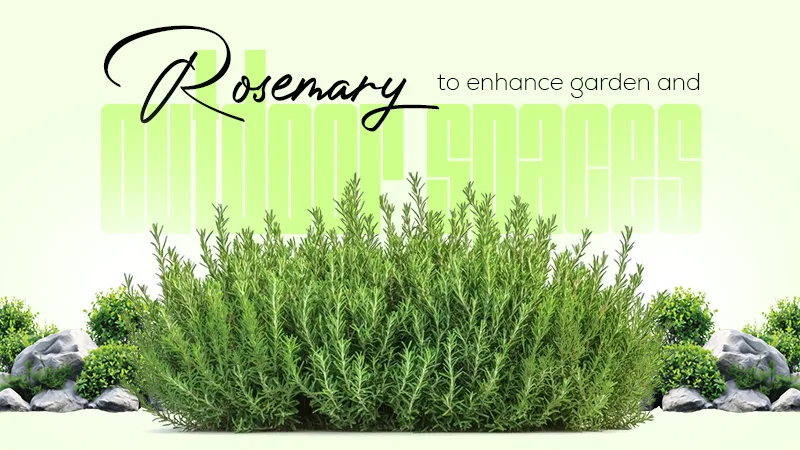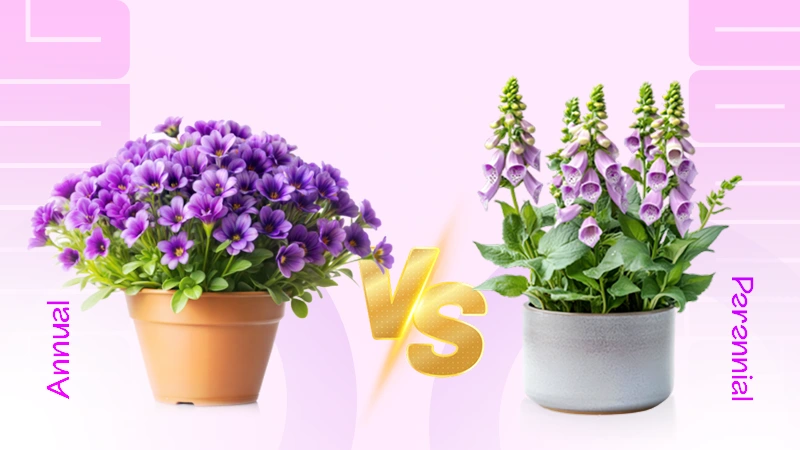The Colocasia, or elephant ear, is a prevalent homegrown plant that is mainly known for its huge and lush velvety leaves. This indoor plant comes in so many varieties and patterns that no two plants will ever look the same!
The most fun and important fact about this plant is that its leaves can grow up to 3–6 feet long (depending on the growing conditions) and give your home a tropical and fresh look!
This article is the sole guide you’ll need to know how to grow elephant ear plants indoors and outdoors from scratch, along with essential care tips and tricks.
Elephant Ear Plants: Brief Overview
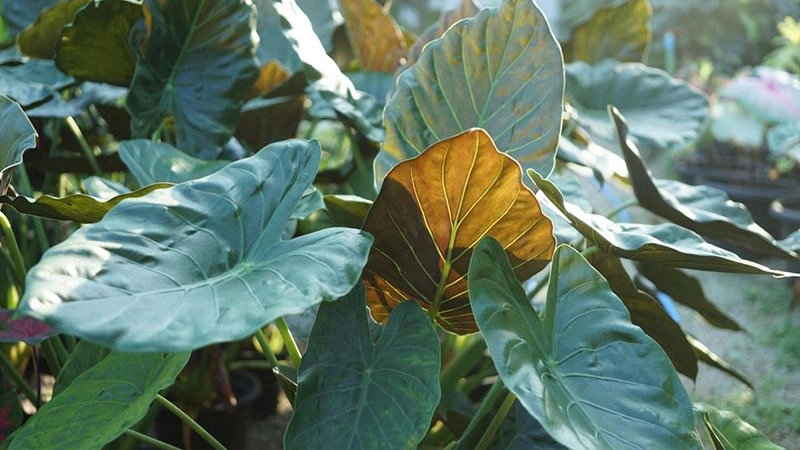
Scientifically known as Colocasia and Alocasias (occasionally), the elephant ear plant is mainly known for its large, dramatic foliage and has become a popular choice among plant enthusiasts.
The plant’s leaves particularly represent the shape and size of the elephant’s ears and are a group of tropical plants from the family Araceae, particularly from the genera Colocasia, Alocasia, and Xanthosoma.
Warning: Elephant’s Ear is toxic to humans and pets, so you should be cautious around them!
| Overview of Elephant Ear Plant | |
| Height | 3′ — 6′ (90 cm — 180 cm) |
| Plant Family | Araceae |
| Climate Zones | 12, 16, 17, 18, 19, 20, 21, 22, 23, 24, H1, H2 |
| Water Needs | Average, High |
| Plant Type | Aquatic Plants, Bulbs, Perennials |
| Exposure | Partial Sun |
| Season of Interest | Spring (Early, Mid, Late) Summer (Early, Mid, Late) Fall Winter |
| Spread | 3′ — 6′ (90 cm — 180 cm) |
| Maintenance | Low |
| Tolerance | Wet Soil, Deer, Rabbit |
| Characteristics | Showy |
| Soil Type | Clay, Loam, Sand |
| Soil pH | Acid, Neutral |
When and Where to Grow the Elephant Ear Plant?
Elephant’s Ear is a plant that thrives in moist soil, warm climate, and shade, which makes a perfect choice if you have a shaded porch or patio and want to bring it alive.
Growing and keeping these little green companions happy and thriving is no difficult task! A little love and a little care, and they’ll grow like crazy! Here’s a full guide on when, where, and how to grow these plants.
When is the Best Time to Grow the Elephant Ear Houseplant?
The best time to grow an Elephant Ear plant is during spring—throughout the summer months when the temperature is high, between 60° and 85° F, and the plant can get the most sunlight.
They need as much sunlight (preferably shaded sunlight) as they can to help the leaves grow large and sustain their color.
It will likely die in places with extremely low temperatures or in winters with no sunlight, but don’t worry, it’ll come alive again in spring!
Where to Plant Colocasia for Best Results?
As I’ve mentioned above, the elephant ear houseplant thrives best in warm conditions and tropical climates.
Warm temperature and moist soil are two of the most important things when it comes to the elephant ear plant. The best place for this gigantic plant is marshy land near a pond, but if you’re planting it at home, I’d strongly suggest a huge planter to start so that you don’t have to repot it every second month.
Make sure you keep the plant in partial to full sunlight and water it regularly, especially in the summer. Plant them in moderately warm and slightly acidic soil to bring out the best results.
How to Grow Elephant Ear Plant—A Detailed Guide
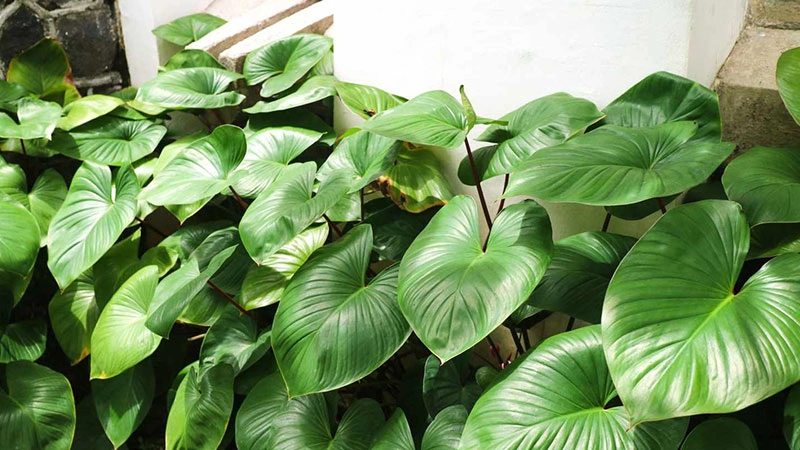
If you’re purchasing an already sprouted and planted Colocasia, then all you have to do is follow some caring tips that we’ll discuss further in the article.
Now that you already know when and where you can plant Colocasia, let’s come to how you can plant them from scratch.
How to Plant Elephant Ears From Scratch?
Planting elephant ears is not a big task; it might not take much physical labor, but you need a good amount of patience since they can be a little slow to grow. Here are some simple steps to grow the Colocasia plant.
- Firstly, you’ll need a tuber that will sprout under the soil and build the foundation for the plant.
- Start the planting process in the spring when the soil is warm without any danger of frost.
- It’s best if you have a piece of land to grow the elephant ear plant, but if you don’t, take up a huge planter and loosen up the soil up to 8’’ deep.
- Now dig a hole 5’’ deep and place the tuber in the center.
- Make sure the pointed area of the tuber is facing upwards; if you can’t determine the pointed side, then just place the tuber horizontally, and the nod will go upward, and the roots will sprout downward.
- Place the tuber in a way that the top is still at least 1’’ deep after you cover it with soil.
- After covering the tuber, water it thoroughly, making sure that the soil is wet but not soggy.
That’s it! You have successfully planted your elephant ear plant! Now all you have to do is wait for it to sprout, which might take anywhere from 3 to 6 weeks before you can see anything on the surface.
Tip: The bigger the bulb you choose, the deeper you need to place it.
Elephant Ear Houseplant Caring Tips
The more love you give to your plants, the more they’ll thrive, and taking care of an elephant ear is as easy as growing it from scratch. Here are some important information and caring tips that will be a complete game changer.
1. Soil
- The soil needs to be moderately warm, at around 70° F.
- It’s best if the soil is slightly acidic with a pH between 5.5 and 6.5, well-drained, and high in organic matter.
- While planting, water the soil enough so that it’s moist but not soggy.
- You can also use perlite to aerate the soil.
- If your plant is placed outside, water it regularly, but if it’s placed inside, let the soil dry out slightly before watering.
2. Light
- The elephant ear plant grows best in partial sunlight, shade, or filtered sunlight.
- If the sunlight is too strong, make sure to not place your plant directly under it; prolonged sunlight can scorch the leaves.
- The best time to let your Colocasia bathe in the sun is during the morning and the evening sunlight.
- If your Colocasia has rich green or dark-colored leaves, you can leave them under the sunlight for a few more hours to maintain their color.
3. Temperature and humidity
- The Colocasia plant overjoys in high humidity above 50% and enjoys a high temperature from 70° to 85°F.
- When it’s winter and the climate is cool with no sun, bring in the plant and place it in a cool, humid corner of the house.
4. Fertilizers
- Fertilize your elephant ear frequently to support larger leaves.
- Choose a water-soluble fertilizer with a good and equal quantity of phosphorus, nitrogen, and potassium in a 20-20-20 ratio.
- Do not fertilize the plant in the dormancy period in winter.
5. Pruning
- Pruning is basically cutting away the rotten and damaged part of the plant; some people might overlook it, but it’s an extremely important process.
- Cut the damaged leaves individually using a pair of disinfected scissors.
- Remember to cut the foliage before frost to about 6 inches above the ground and dig up tubers.
- Along with pruning, make sure to clean the leaves with a damp cloth or paper at least once a month to clear away the dust and make them look more bright and lively.
Fun Fact: Some species of the elephant ear plant, namely Taro, Eddoe, and Dasheen, are consumed as a delicacy in some places.
Propagating and Repotting Elephant Ear Plants
Tropical plant owners generally love to propagate their plants, which makes for a great gift. The best way to propagate the elephant ear plant is to divide the tubers and roots instead of dividing the seed near the end of the growing season in the fall.
Repotting is also an inevitable process; the leaves of an elephant ear can become gigantic, and the roots eventually grow out of the pot. The process of repotting is even easier than growing from scratch.
Propagating:
- Carefully dig the tubers and loosen up the roots. Wear gloves to protect your skin from the sap.
- Divide them with a sharp, sterile knife, ensuring each section has at least one growth bud.
- Place the separated tuber on a tray away from direct sunlight at room temperature. Let the tuber air-dry for about a week or a few days.
- Apply fungicide to the roots, wrap it in paper, and place it in a cool area. Also, check for rotting every few weeks and discard any infected tubers.
- Plant the tuber in spring when the soil is warm, and water the soil regularly for healthy growth.
Repotting:
- While repotting, always use a bigger planter than the previous one, since large-volume containers are easier to keep moist.
- Make sure that the container you’re using has ample holes for drainage.
- Prepare a combination of potting mix, vermiculite, and perlite to provide a good amount of organic matter for nutrients.
- Fish out the plant from the pot.
- Sprinkle the combination mix you made in the bottom of the new pot and adjust the plant above it after you’ve loosened the roots.
- Fill the pot with the soil and fertilizer, and add some stones if you want.
Elephant Ear Plant Types
There are numerous varieties of elephant ear plants, like the black elephant ear plant and the purple elephant ear plant. Here are some popular varieties like Colocasia, Alocasia, Caladium, etc.
1. Colocasia
One way to identify the Colocasia type is that the leaves of the plant will be bent and look droopy.
A) Colocasia esculenta Black Magic
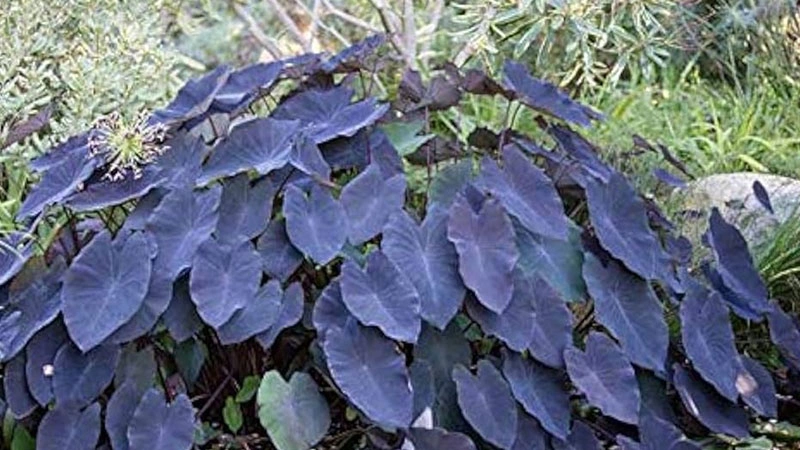
Colocasia esculenta ‘Black Magic’ is a striking cultivar of the Colocasia species, commonly known for its deep purple, almost black elephant ear plant, foliage, which makes it a standout plant in gardens and landscapes.
| Requirements | |
| Height | 3′ — 6′ (90 cm — 180 cm) |
| Genus | Colocasia |
| Plant Family | Araceae |
| Climate Zones | 12, 16, 17, 18, 19, 20, 21, 22, 23, 24, H1, H2 |
| Water Needs | Average, High |
| Plant Type | Aquatic Plants, Bulbs, Perennials |
| Exposure | Partial Sun |
| Season of Interest | Spring (Early, Mid, Late) Summer (Early, Mid, Late) Fall Winter |
| Spread | 3′ — 6′ (90 cm — 180 cm) |
| Spacing | 72″ (180cm) |
| Maintenance | Low |
| Tolerance | Wet Soil, Deer, Rabbit |
| Characteristics | Showy |
| Soil Type | Clay, Loam, Sand |
| Soil pH | Acid, Neutral |
B) Colocasia esculenta Black Stem
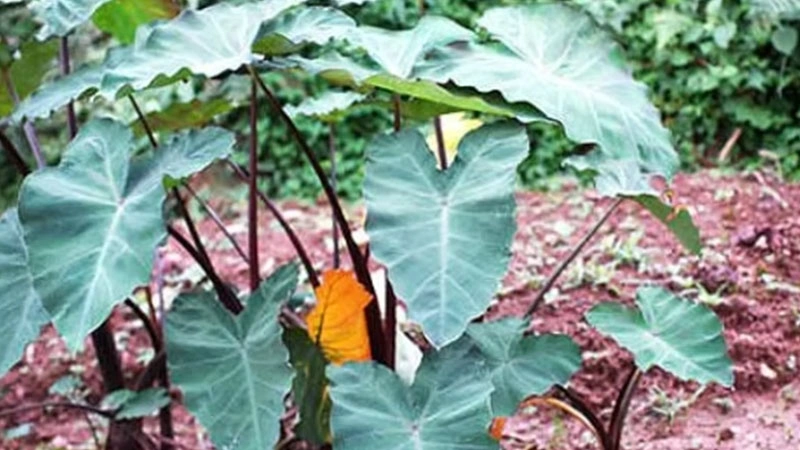
Colocasia esculenta ‘Black Stem’ is a stunning variety of Colocasia, also known as elephant ear, popular for its unique black stems and large, lush green leaves.
| Requirements | |
| Height | 5′ — 6′ (150 cm — 180 cm) |
| Genus | Colocasia |
| Plant Family | Araceae |
| Climate Zones | 12, 16, 17, 18, 19, 20, 21, 22, 23, 24, H1, H2 |
| Water Needs | Average, High |
| Plant Type | Aquatic Plants, Bulbs, Perennials |
| Exposure | Full sun, Partial Sun |
| Season of Interest | Spring (Early, Mid, Late) Summer (Early, Mid, Late) Fall Winter |
| Spread | 4′ — 6′ (120 cm — 180 cm) |
| Spacing | 24″ — 36″ (60 cm — 90 cm) |
| Maintenance | Low |
| Tolerance | Wet Soil, Deer, Rabbit |
| Characteristics | Showy |
| Common Names | Elephant ear, Taro |
| Soil Type | Clay, Loam, Sand |
| Soil pH | Acid, Neutral |
C) Colocasia esculenta Diamond Head
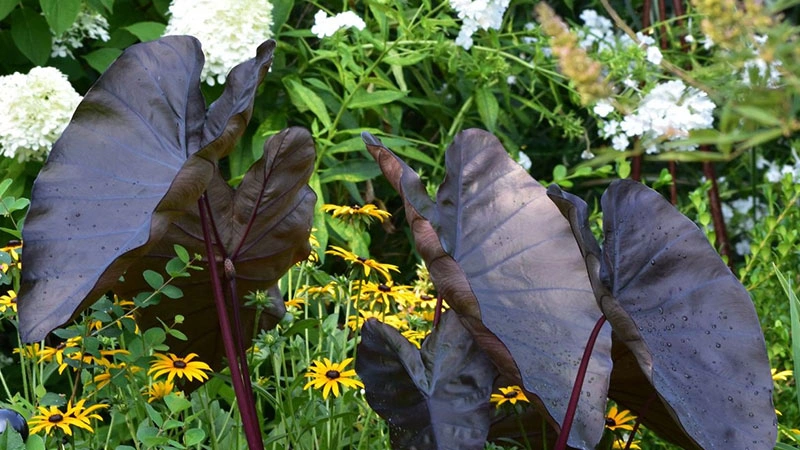
Colocasia esculenta ‘Diamond Head’ is a beautiful variety of Elephant Ear plant known for its deep, glossy, almost metallic black-purple leaves. The huge, gorgeous leaves stand out in any garden due to their dramatic foliage and bold presence.
| Requirements | |
| Height | 3′ — 4′ (90 cm — 120 cm) |
| Genus | Colocasia |
| Plant Family | Araceae |
| Climate Zones | 12, 16, 17, 18, 19, 20, 21, 22, 23, 24, H1, H2 |
| Water Needs | Average, High |
| Plant Type | Aquatic Plants, Bulbs, Perennials |
| Exposure | Full sun, Partial Sun |
| Season of Interest | Spring (Early, Mid, Late) Summer (Early, Mid, Late) Fall Winter |
| Spread | 2′ — 3′ (120 cm — 180 cm) |
| Spacing | 36″ (90 cm) |
| Maintenance | Low |
| Tolerance | Wet Soil, Deer, Rabbit |
| Characteristics | Showy |
| Common Names | Elephant ear, Taro |
| Soil Type | Clay, Loam, Sand |
| Soil pH | Acid, Neutral |
D) Colocasia esculenta Mojito
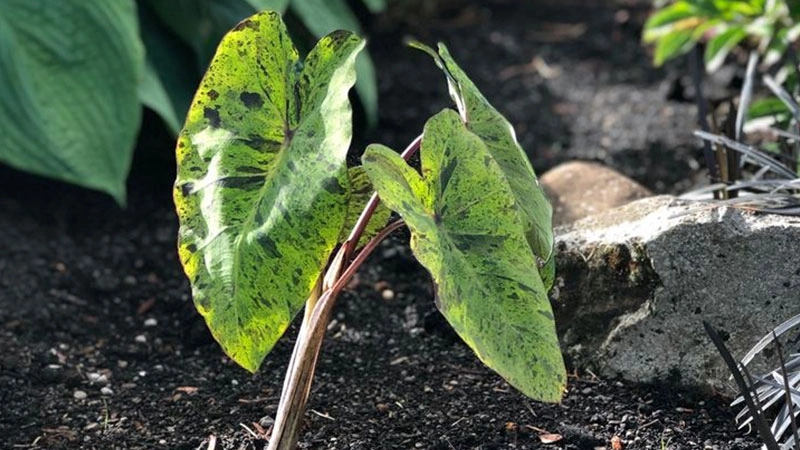
Mojito’s variegated foliage is beautiful, with the unusual patterns of blue-black dashes and splashes. The pattern is so irregular that no two leaves look alike. Like other elephant ears, Mojito needs warm soil and plenty of moisture.
| Requirements | |
| Height | 4′ — 5′ (120 cm — 150 cm) |
| Genus | Colocasia |
| Plant Family | Araceae |
| Climate Zones | 12, 16, 17, 18, 19, 20, 21, 22, 23, 24, H1, H2 |
| Water Needs | Average, High |
| Plant Type | Aquatic Plants, Bulbs, Perennials |
| Exposure | Full sun, Partial Sun |
| Season of Interest | Spring (Early, Mid, Late) Summer (Early, Mid, Late) Fall Winter |
| Spread | 4′ — 5′ (120 cm — 150 cm) |
| Spacing | 4′ — 5′ (120 cm — 150 cm) |
| Maintenance | Low |
| Tolerance | Wet Soil, Deer, Rabbit |
| Characteristics | Showy |
| Common Names | Elephant ear, Taro |
| Soil Type | Clay, Loam, Sand |
| Soil pH | Acid, Neutral |
E) Colocasia esculenta Tea Cup
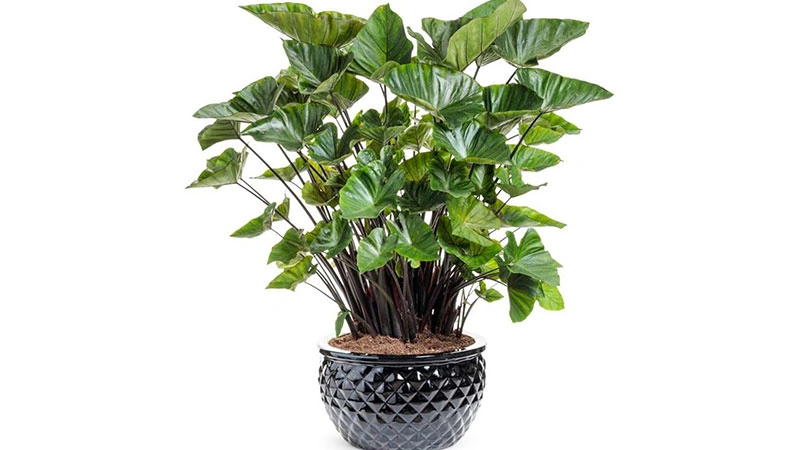
Known for its upright, cup-shaped leaves that collect water, resembling the shape of a tea cup. This cultivar stands out due to its unusual leaf structure and dramatic appearance, making it a popular choice for tropical-themed gardens.
| Requirements | |
| Height | 5′ — 6′ (150 cm — 180 cm) |
| Genus | Colocasia |
| Plant Family | Araceae |
| Climate Zones | 12, 16, 17, 18, 19, 20, 21, 22, 23, 24, H1, H2 |
| Water Needs | Average, High |
| Plant Type | Aquatic Plants, Bulbs, Perennials |
| Exposure | Full sun, Partial Sun |
| Season of Interest | Spring (Early, Mid, Late) Summer (Early, Mid, Late) Fall Winter |
| Spread | 4′ — 6′ (120 cm — 180 cm) |
| Spacing | 24″ — 36″ (60 cm — 90 cm) |
| Maintenance | Low |
| Tolerance | Wet Soil, Deer, Rabbit |
| Characteristics | Showy |
| Common Names | Elephant ear, Taro |
| Soil Type | Clay, Loam, Sand |
| Soil pH | Acid, Neutral |
2. Alocasia
Alocasia is the type of elephant ear plant that has leaves pointing up in the air, which is one way to identify them.
A) Alocasia Cucullata
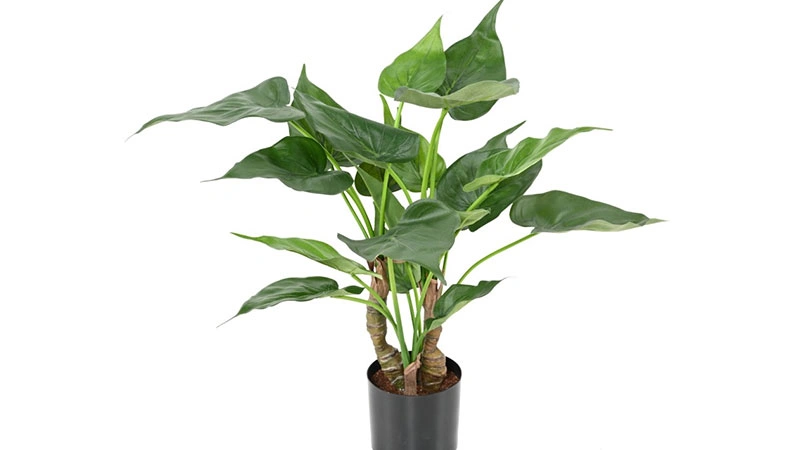
The Alocasia Cucullata, also known as the Chinese Alocasia, Buddha’s Palm, or Hooded Dwarf elephant ear, is notable for its lush, tropical appearance and cultural relevance in Asia.
| Requirements | |
| Height | 2′ — 3′ (60 cm — 90 cm) |
| Genus | Alocasia |
| Plant Family | Araceae |
| Climate Zones | 12, 16, 17, 18, 19, 20, 21, 22, 23, 24, H1, H2 |
| Water Needs | Average, High |
| Plant Type | Aquatic Plants, Bulbs, Perennials |
| Exposure | Full sun, Partial Sun |
| Season of Interest | Spring (Early, Mid, Late) Summer (Early, Mid, Late) Fall Winter |
| Spread | 2′ — 3′ (60 cm — 90 cm) |
| Spacing | 24″ — 36″ (60 cm — 90 cm) |
| Maintenance | Low |
| Tolerance | Wet Soil, Deer, Rabbit |
| Characteristics | Showy, evergreen |
| Common Names | Elephant ear |
| Soil Type | Loam, Sand |
| Soil pH | Acid, Neutral |
B) Alocasia Wentti
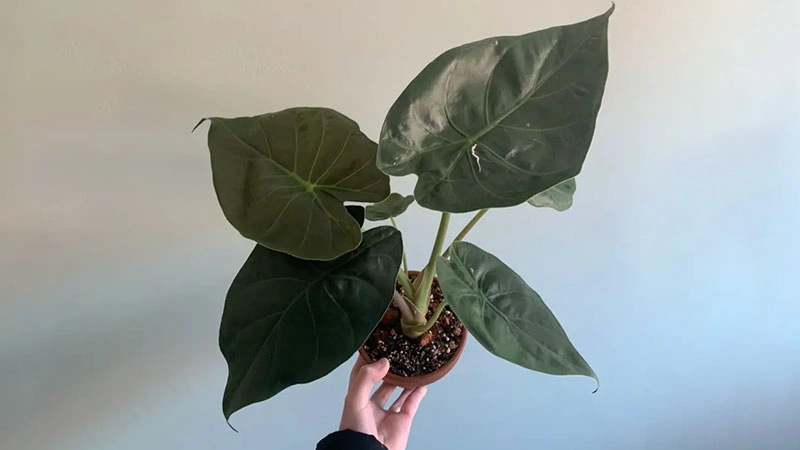
Alocasia Wentii, also known as the New Guinea shield, African mask plant, or the Hardy elephant ear, is a must-have for any plant lover. It has super glossy leaves and a unique color with a purple underside.
| Requirements | |
| Height | 2′ — 3′ (60 cm — 90 cm) |
| Genus | Alocasia |
| Plant Family | Araceae |
| Climate Zones | 12, 16, 17, 18, 19, 20, 21, 22, 23, 24, H1, H2 |
| Water Needs | Average, High |
| Plant Type | Aquatic Plants, Bulbs, Perennials |
| Exposure | Full sun, Partial Sun |
| Season of Interest | Spring (Early, Mid, Late) Summer (Early, Mid, Late) Fall Winter |
| Spread | 2′ — 3′ (60 cm — 90 cm) |
| Spacing | 24″ — 36″ (60 cm — 90 cm) |
| Maintenance | Low |
| Tolerance | Wet Soil, Deer, Rabbit |
| Characteristics | Showy, evergreen |
| Common Names | Elephant ear |
| Soil Type | Loam, Sand |
| Soil pH | Acid, Neutral |
C) Alocasia Silver Dragon

Alocasia Silver Dragon is truly a one-of-a-kind plant with breathtaking silver leaves that just look out of the world. This plant is part of the Jewel Alocasia series, but it can stand on its own with its fascinating color pattern.
| Requirements | |
| Height | 1′ — 2′ (30 cm — 60 cm) |
| Genus | Alocasia |
| Plant Family | Araceae |
| Water Needs | Average |
| Plant Type | Houseplant, Perennials |
| Exposure | Full sun, Partial Sun |
| Season of Interest | Spring (Early, Mid, Late) Summer (Early, Mid, Late) Fall Winter |
| Spread | 1′ — 2′ (60 cm — 90 cm) |
| Spacing | 12″ — 24″ (30 cm — 60 cm) |
| Maintenance | Low |
| Soil Drainage | Moist but well-drained |
| Characteristics | Showy, evergreen |
| Common Names | Elephant ear |
| Soil Type | Loam, Sand |
| Soil pH | Acid, Neutral |
D) Alocasia Jacklyn
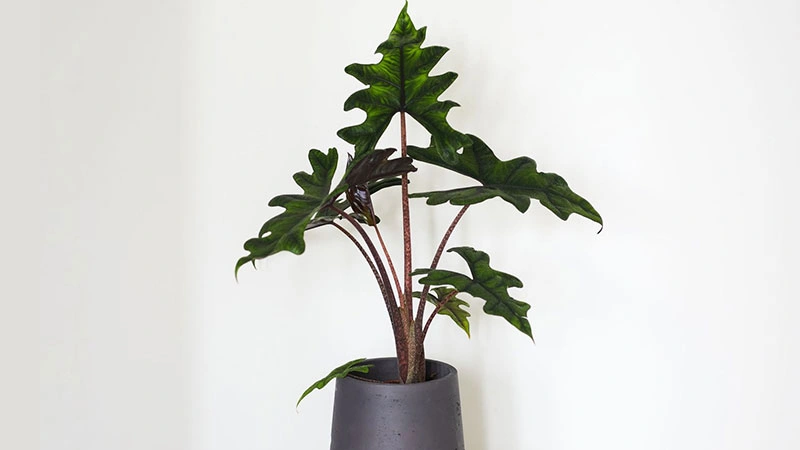
The Alocasia Jacklyn is a newly discovered species in the aroid family and native to Indonesia. The striking combination of green leaves, dark lines, and a stem of tiger strips really stands out.
| Requirements | |
| Height | 2′ — 3′ (60 cm — 90 cm) |
| Genus | Alocasia |
| Plant Family | Araceae |
| Water Needs | Average |
| Plant Type | Houseplant, Perennials |
| Exposure | Full sun, Partial Sun |
| Season of Interest | Spring (Early, Mid, Late) Summer (Early, Mid, Late) Fall Winter |
| Spread | 2′ — 3′ (60 cm — 90 cm) |
| Spacing | 12″ — 24″ (30 cm — 60 cm) |
| Maintenance | Low |
| Soil Drainage | Moist but well-drained |
| Characteristics | Showy, evergreen |
| Common Names | Elephant Ear |
| Soil Type | Loam, Sand |
| Soil pH | Acid, Neutral |
E) Alocasia Black Velvet

True to its name, the leaves of this plant appear to be black and velvety and is an ideal indoor plant native to the tropical places of Southeast Asia. ‘Black Velvet’ can create a striking impression even in small spaces.
| Requirements | |
| Height | 1′ — 2′ (30 cm — 60 cm) |
| Genus | Alocasia |
| Plant Family | Araceae |
| Water Needs | Average |
| Plant Type | Houseplant, Perennials |
| Exposure | Full sun, Partial Sun |
| Season of Interest | Spring (Early, Mid, Late) Summer (Early, Mid, Late) Fall Winter |
| Spread | 1′ — 2′ (60 cm — 90 cm) |
| Spacing | 12″ — 24″ (30 cm — 60 cm) |
| Maintenance | Low |
| Soil Drainage | Moist but well-drained |
| Characteristics | Showy, evergreen |
| Common Names | Elephant ear |
| Soil Type | Loam, Sand |
| Soil pH | Acid, Neutral |
F) Alocasia Polly Amazonica
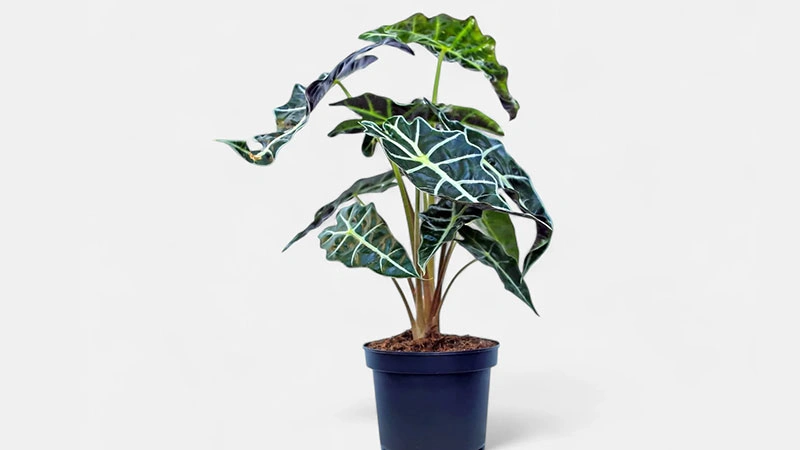
Alocasia Polly Amazonica is a beautiful indoor plant with glossy, heart-shaped leaves and white veining. Although it can produce small Elephant Ear flowers in suitable conditions, it is primarily recognized for its stunning leaves.
| Requirements | |
| Height | 1′ — 2′ (30 cm — 60 cm) |
| Genus | Alocasia |
| Plant Family | Araceae |
| Water Needs | Average |
| Plant Type | Houseplant, Perennials |
| Exposure | Partial Sun |
| Season of Interest | Spring (Early, Mid, Late) Summer (Early, Mid, Late) Fall Winter |
| Spread | 1′ — 2′ (60 cm — 90 cm) |
| Spacing | 12″ — 24″ (30 cm — 60 cm) |
| Maintenance | Low |
| Soil Drainage | Moist but well-drained |
| Characteristics | Showy, Evergreen |
| Common Names | Elephant Ear |
| Soil Type | Loam, Sand |
| Soil pH | Acid, Neutral |
3. Xanthosoma
Xanthosoma is a genus type of Elephant Ear Flowering Plant of the Arum family, Araceae, and is native to tropical America. This plant is mainly grown as an important food staple in tropical regions.
A) Adelonema crinipes
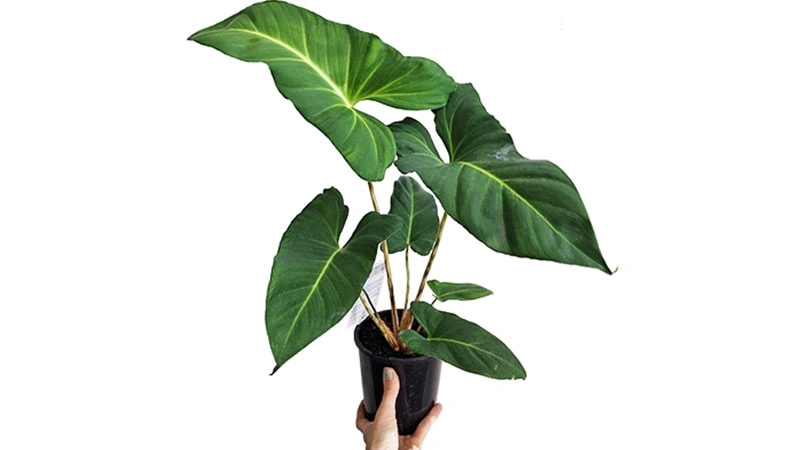
Adelonema crinipes is a cool and weird aroid. As it matures, it produces narrow hastate leaves with white veins that emerge down the middle of each leaf. The stem might have a thorn-like structure.
| Requirements | |
| Height | 1′ — 2′ (30 cm — 60 cm) |
| Genus | Xantosoma |
| Plant Family | Araceae |
| Water Needs | Average |
| Plant Type | Houseplant, Perennials |
| Exposure | Partial Sun |
| Season of Interest | Spring (Early, Mid, Late) Summer (Early, Mid, Late) Fall Winter |
| Spread | 1′ — 2′ (60 cm — 90 cm) |
| Spacing | 12″ — 24″ (30 cm — 60 cm) |
| Maintenance | Low |
| Soil Drainage | Moist but well-drained |
| Characteristics | Showy, Evergreen |
| Common Names | Elephant ear |
| Soil Type | Loam, Sand |
| Soil pH | Acid, Neutral |
B) Xanthosoma sagittifolium
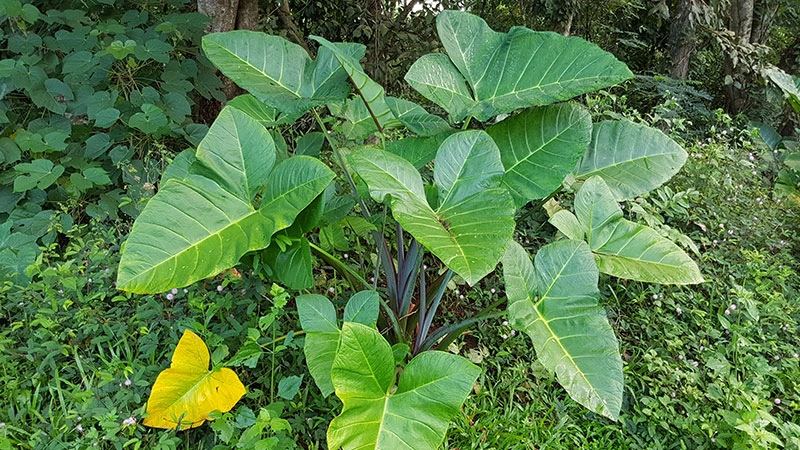
Xanthosoma sagittifolium is a tropical elephant ear flowering plant from the family of Araceae. The plant is consumed in many regions of tropical America, where it was first cultivated.
| Requirements | |
| Height | 2′ — 3′ (60 cm — 90 cm) |
| Genus | Xanthosoma |
| Plant Family | Araceae |
| Water Needs | Average |
| Plant Type | Houseplant, Perennials |
| Exposure | Full sun, Partial Sun |
| Season of Interest | Spring (Early, Mid, Late) Summer (Early, Mid, Late) Fall Winter |
| Spread | 2′ — 3′ (60 cm — 90 cm) |
| Spacing | 12″ — 24″ (30 cm — 60 cm) |
| Maintenance | Low |
| Soil Drainage | Moist but well-drained |
| Characteristics | Showy, evergreen |
| Common Names | Elephant ear |
| Soil Type | Loam, Sand |
| Soil pH | Acid, Neutral |
C) Xanthosoma Mafaka
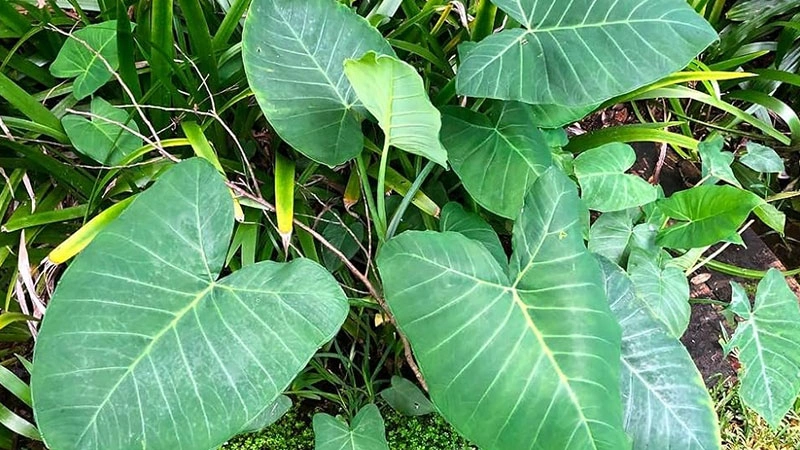
Xanthosoma ‘Mafaka’ is a rare and unique variety of the Xanthosoma genus, which is closely related to the Colocasia genus (commonly known as elephant ears). Xanthosoma plants are known for their large, tropical-looking leaves.
| Requirements | |
| Height | 2′ — 3′ (60 cm — 90 cm) |
| Genus | Xanthosoma |
| Plant Family | Araceae |
| Water Needs | Average |
| Plant Type | Houseplant, Perennials |
| Exposure | Full sun, Partial Sun |
| Season of Interest | Spring (Early, Mid, Late) Summer (Early, Mid, Late) Fall Winter |
| Spread | 2′ — 3′ (60 cm — 90 cm) |
| Spacing | 12″ — 24″ (30 cm — 60 cm) |
| Maintenance | Low |
| Soil Drainage | Moist but well-drained |
| Characteristics | Showy, evergreen |
| Common Names | Elephant ear |
| Soil Type | Loam, Sand |
| Soil pH | Acid, Neutral |
D) Xanthosoma Lime Zinger
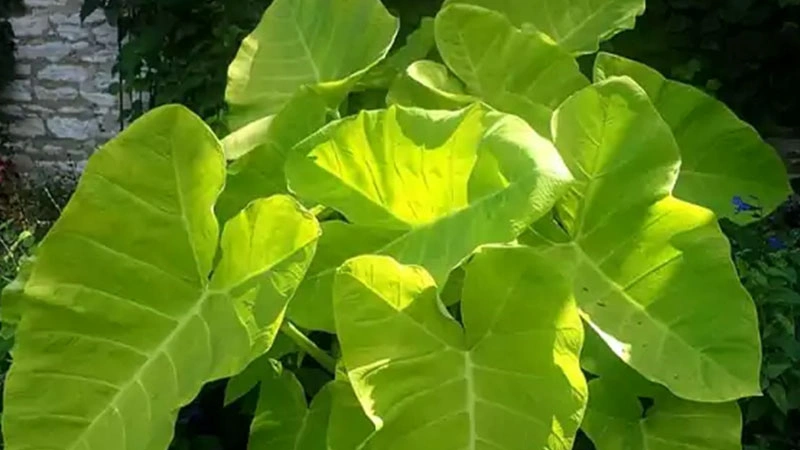
Just like the name suggests, the Xanthosoma Lime Zinger plant is light green, almost like lime in color. Grown mostly for its foliage, this cultivar will often grow over 1 m tall and the same in spread.
| Requirements | |
| Height | 1′ — 2′ (30 cm — 60 cm) |
| Genus | Xantosoma |
| Plant Family | Araceae |
| Water Needs | Average |
| Plant Type | Houseplant, Perennials |
| Exposure | Partial Sun |
| Season of Interest | Spring (Early, Mid, Late) Summer (Early, Mid, Late) Fall Winter |
| Spread | 1′ — 2′ (60 cm — 90 cm) |
| Spacing | 12″ — 24″ (30 cm — 60 cm) |
| Maintenance | Low |
| Soil Drainage | Moist but well-drained |
| Characteristics | Showy, Evergreen |
| Common Names | Elephant ear |
| Soil Type | Loam, Sand |
| Soil pH | Acid, Neutral |
How to Save Elephant Ear Plants From Common Pests and Plant Diseases
Plants need lots of love and attention to thrive and grow. Elephant ear is not the needy type; you still need to be on the lookout for certain types of pests and plant diseases that are commonly found in elephant ear plants.
1. Aphids:
- Description: These are tiny, soft-bodied insects that suck the sap from plant tissues and cause the leaves to become distorted and yellow.
- Symptoms: You’ll notice a sticky honeydew on the leaves and stems, along with distorted or curled leaves.
- Control: Use insecticidal soap or neem oil, which is an essential oil of your plant. Spray IT on the affected areas.
2. Spider Mites:
- Description: These are small, red, or brown mites that are extremely difficult to see with the naked eye. They also suck plant sap, causing damage.
- Symptoms: You might notice fine webbing on the undersides of leaves, yellowing or browning of the foliage, and speckled leaves.
- Control: Increase humidity around the plant and use insecticidal soap or neem oil.
3. Mealybugs:
- Description: Mealybugs are small, white, cotton-like insects that feed on plant sap.
- Symptoms: You might notice white, cottony masses on the stems, leaves, or roots. The leaves may turn yellow and fall off.
- Control: Remove mealybugs with a cotton swab dipped in rubbing alcohol and use neem oil for control.
4. Thrips:
- Description: Thrips are tiny, slender insects that feed by scraping plant tissues and sucking up sap.
- Symptoms: You might notice silvery or streaked leaves and tiny black spots of excrement on the leaves that were not originally there.
- Control: Prune the heavily infested areas and treat with insecticidal soap or neem oil.
5. Scale Insects:
- Description: Small, round, or oval insects that attach themselves to stems and leaves, forming a hard, protective coating.
- Symptoms: Sticky honeydew on leaves, yellowing foliage, and leaf drop.
- Control: Manually remove scales with a soft brush and apply horticultural or neem oil.
6. Slugs and Snails:
- Description: Common pests in moist environments, they feed on the large leaves, causing holes and ragged edges.
- Symptoms: Irregular holes in leaves, shiny slime trails on the plant and soil.
- Control: Use organic slug baits, handpick at night, or create barriers with crushed eggshells or diatomaceous earth.
Common Problems You Might Face With Elephant Ear Plant
As I said before, elephant ear plants are easy to grow; however, they do need attention for some common problems they might face, like fungal infection. Here are some of the common problems that you have to look out for in these plants!
- Yellowing of Leaves: Leaves turning yellow means your process and amount of watering and sunlight exposure are not right. They either require more or less sunlight/water. Cut the yellow leaves and keep them healthy.
- Wilting: Wilting is a sign that the plant is receiving too much sun or heat, plus not enough water. The plant will appear drooped with no life.
- Scorched leaves: I think it is quite clear what the concern here is. The leaves of the plant will appear burned or scorched in case you place them under direct and bright sunlight.
- Stunned and pale leaves: This condition signifies that your plant requires more nutrition, light, or water. Generally, dark-colored leaves turn pale when not given enough sunlight to maintain their color.
Final Words
Elephant ear plants bring an exotic, tropical vibe to any space with their large, dramatic leaves. Whether grown in the garden, as a water feature, or as an indoor plant, these versatile and easy-to-care-for plants are a favorite among gardeners.
With the right care, they can thrive and become a focal point in any landscape, adding a lush green presence that transforms outdoor and indoor spaces into tropical paradises.
Where is best to plant elephant ears?
Elephant Ears perform best in sun or part shade. While most can be grown in partial shade, the darker-colored varieties are best grown in full sun.
Is elephant ear plant lucky?
Yes, the plant is said to bring good luck because it is believed to be able to ward off evil spirits.
Are Elephant Ear Plants Poisonous?
Elephant ears contain oxalate crystals, which are irritating to the skin. Once cooked, the plant is edible.
Why Is My Elephant Ear Plant Drooping?
The most likely reason for drooping elephant ear foliage is lack of moisture. The soil should never fully dry out. Check the soil and keep it well watered.
Do elephant ears grow indoors?
Elephant ears can be grown as houseplants as long as they are in a bright spot, such as a sunny window with southern or west exposure that offers indirect light.
What is the difference between Colocasia and Alocasia plants?
The main difference between Colocasia and Alocasia plants is in their leaves. Colocasia leaves droop downward, while Alocasia leaves usually point upward.
Can you grow elephant ear plant from cuttings?
Elephant Ear plant propagation from cuttings is uncommon. This is especially true for Caladiums. The best method of growing new plants from existing ones is division.

